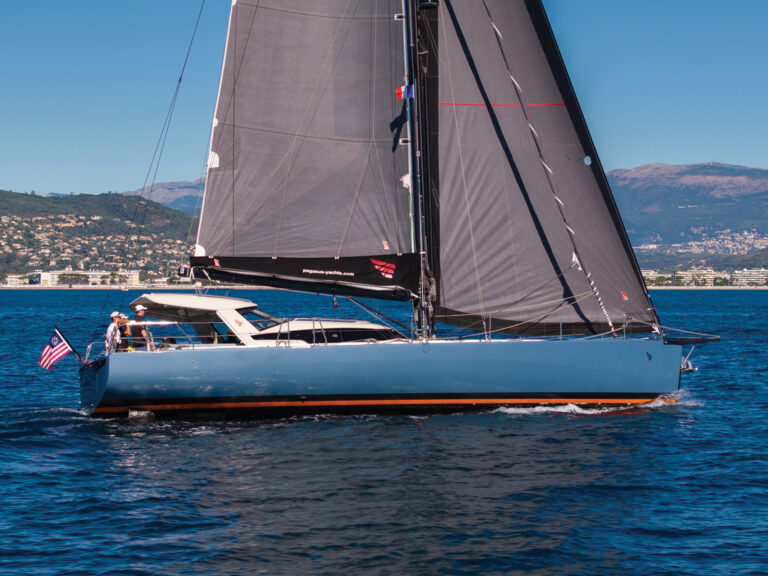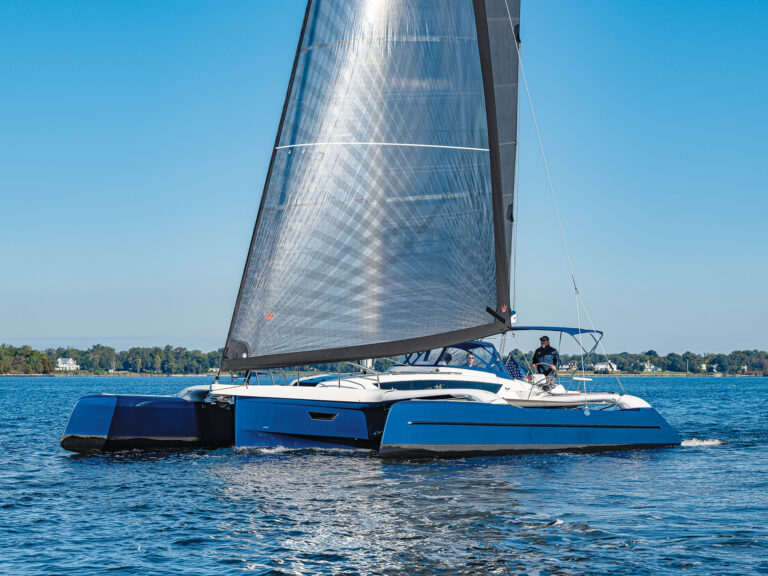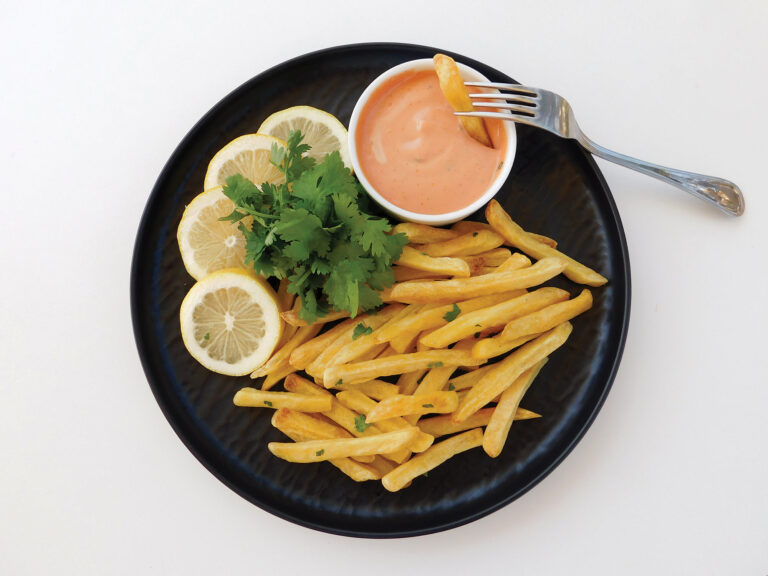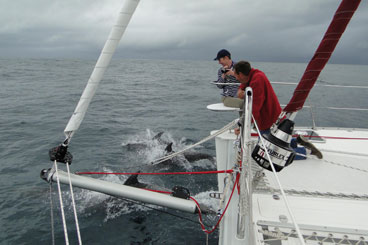
From Zero to a Hundred
The clock was ticking, and vague notions of a winter home in Mexico weren’t quite cutting it.
Canadians Craig Acott and Laurie Bowers knew that they were right on track. They saw retirement looming after Craig’s successful career as a geological consultant and mining engineer and Laurie’s fulfilling years as a teacher and principal. Self-avowed nature lovers, they’d made trips to scope out properties south of the U.S. border. But still. They weren’t sure, and nothing was grabbing at them.
One thing was clear.
“Sitting around and taking care of a vacation home isn’t exactly what I thought we wanted to do when we finished work,” says Craig.
On a trip she took with her cousin, Laurie, a recreational ocean kayaker, found herself gliding along glasslike Cow Bay, off Prince Rupert, British Columbia. And there, she saw it, a two-hulled sailboat. But what was it?
Having never sailed, and completely unfamiliar with anything having to do with boats, much less hull design, Laurie went back home to Calgary and, with Craig, pieced together some notion of what she’d discovered.
The more they dug, the more they found. The learning curve had officially kicked in, whether or not they realized it. The next thing they knew, they were walking the docks and looking at boats at the spring 2007 Strictly Sail Boat Show in Oakland, California.
“We didn’t have the sailing language,” Laurie says. “We had nothing. We knew nothing about anything. But it was exciting. We saw that cruising on our own boat wasn’t going to be passive. It would challenge us physically and mentally. The only thing we understood was that this was for us. It’s the life we knew we wanted. We went from zero to a hundred.”
**
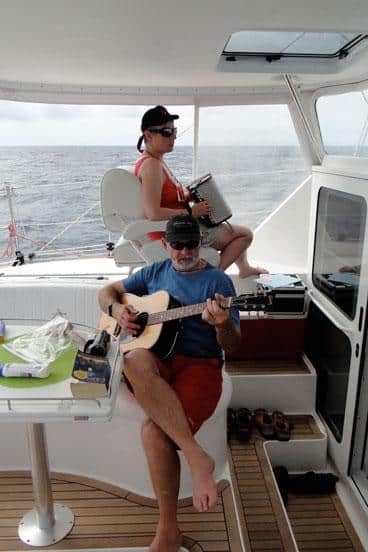
Chance Meetings**
Like a couple of college kids pulling a string of all-nighters, they crammed and jammed. They bought the magazines. They inhaled the works of such multihull experts as author Charles Kanter. They took sailing lessons any way and anywhere they could. Dinghy lessons, monohull lessons, women-only lessons for Laurie, weeks aboard with instructors in locales from the Pacific Northwest to Belize and San Diego—the odyssey was gaining momentum.
“We learned to sail in San Diego Bay,” says Craig. “It’s like learning to drive in New York City.”
After gaining confidence in San Diego among the multitudes of commercial, pleasure, and military traffic, they got their wits about them and came to appreciate how fairly predictable weather patterns helped them focus on the sailing itself. They went to the next step, liveaboard lessons.
“The first time we had an instructor leave us, and we anchored to stay overnight on our own, it wasn’t pretty,” Craig says. “But we did it, after just a week, which is amazing. Instructors are so impressive in their ethics and attention to safety. They possess military-like attention to detail. And it was good to get lessons in different places in the world. In Belize, we learned to deal with coral. In the Pacific Northwest, it was the currents and the tides.”
They were quickly approaching a crossroad, and they sensed it. In 2007, they attended the fall U.S. Sailboat Show in Annapolis, Maryland, the largest in-water event in the country catering to sailors, one complete with new production-model boats, equipment, and a popular seminar series.
“We knew we wanted a catamaran because we’d be living aboard, and Laurie had seen the cat when she was kayaking,” says Craig. “We were still considering a house in Mexico, and when we went looking at homes on the waterfront, we saw cats in the anchorage.”
Besides climbing aboard every catamaran on the docks and talking to builders, they spent an afternoon with owners in the nearby anchorage aboard_ Leap of Faith_, a 44-footer, and met with Rob Poirier, the Antares Yachts co-founder who devised the company’s flagship design. (See “Sensible Liveaboards.”)
Pieces of an unwieldy jigsaw puzzle were starting to come together. “The construction and design of the Antares made a lot of sense to me,” says Craig. “We wanted something that we could take offshore for an open-ended journey. We liked the big saloon and that the engines are situated in the center of each hull of the boat.” Adds Laurie: “Access to the engines is easy and comfortable.”
By late 2008, Alberta Crewed was hull number one in production at the company’s new plant in Argentina. Craig and Laurie chose the name as a play on the rich crude-oil resources of their landlocked province of Alberta.
Adventure Next
Now the odyssey was transformed. “Our next life adventure,” as Laurie calls it on her blog, was taking shape. Details were thought through, debated, pinned down. In the next two years, the couple flew to Argentina four times, did deliveries with other owners aboard their Antares cats, and took more sailing lessons.
In October 2010, they quit their jobs, rented out their house, and acquired additional marine licenses. They flew to Buenos Aires, oversaw the stepping of the mast, and soaked up as much as they could from the yard workers. And they got out into the city, enjoying the street scenes and the nightlife, the restaurants and the wine. They grew to know the boatyard owner and managers and were invited into their homes and into their family lives. On the day Alberta Crewed was launched, the factory threw an assado, a big barbecue, and aromas of grilled loin, flank, ribs, and sausage filled the air.
They shoved off in December after participating in a session of Antares University, a custom program for current and future clients, where they continued to learn more about their boat and how to handle it, and met and networked with other owners. After a book-length list of final details and provisioning—which included no fewer than 45 bottles of Mendoza wine—they set out on their maiden voyage, with the goal of inviting relatives to meet them in the Caribbean, on the island of Trinidad.
Of course, it never goes as planned, but for newbies, Craig and Laurie did pretty darn well. Australian friends Greg and Wendy Rodda helped them sail the boat north to Brazil, which was great. From there, others joined the adventure from time to time. The Antares factory crew had sent them off with a network of contacts, routing, and weather advice. There were kinks: Laurie did get seasick, but she learned to manage it with Bonamine (meclozine). Neither of them spoke Spanish or Portuguese, which gave rise to communication woes. At times, the customs and immigration paperwork confounded them.
“I can see why people do run away from this,” says Craig. “We’re still learning.”
“I knew it was going to be hard,” says Laurie with a smile, adding that they were humbled by the generosity extended to them everywhere they made landfall along the South American coast. Most important, they pulled it off, arriving in Trinidad in June 2011, then leaving the boat buttoned up for hurricane season.
When they talk about their trip, they keep coming back to how they lingered off Brazil, especially at Ilha Grande, southwest of Rio de Janeiro. “We didn’t want to leave,” says Laurie. And they met their personal design brief: “We sought three criteria: heat, simplicity, and adventure,” she writes on her blog.
Lessons Learned
Four years later, back at the Annapolis boat show, where much of their odyssey started, Craig and Laurie were relaxed, enjoying meeting up with old friends, making new ones, scoping out gear, and networking with the Antares tribe, an extended family of the company’s employees and clients.
That first cruise in their wake, they now talked of plans for the winter of 2012. First would be a stop in December for a session of Antares University in Grenada. Next on the agenda, return to the boat in nearby Trinidad and head north, first for the Bahamas and then to Miami.
They believe it’s important to pass on to others what they learned, and so they took the time to sit down with me at the boat show in Annapolis. “Be patient with yourself,” says Laurie. “Count on it taking way more time than you think. Sometimes we know way more than we give ourselves credit for. At other times, we think we know way more than we actually do.”
Some uncertainties lingered for Craig, like whether they can handle the boat alone offshore, yet he’s pleased he got to spend time out on the ocean, being active. “There are 4,600 miles in our wake,” he says with a smile, “from Río de la Plata to Trinidad. We were on starboard tack almost the whole time.”
Elaine Lembo is CW_’s deputy editor._





